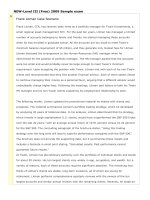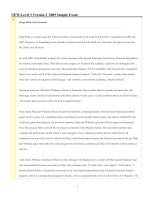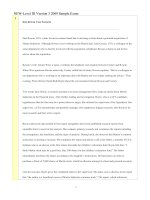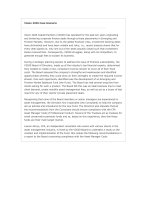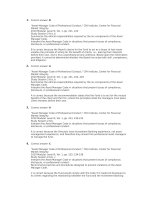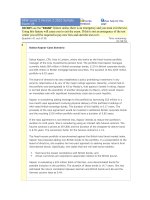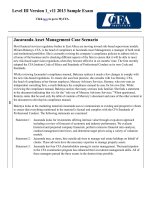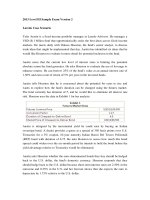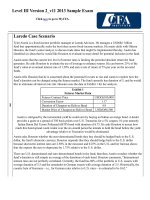2010 l3 sample exam v1
Bạn đang xem bản rút gọn của tài liệu. Xem và tải ngay bản đầy đủ của tài liệu tại đây (103.22 KB, 17 trang )
Vision 2020 Case Scenario
Vision 2020 Capital Partners (V2020) has operated for the past ten years originating and
brokering corporate finance deals through private placements in Emerging and Frontier
Markets. However, due to the global financial crisis, investment banking deals have
diminished and have been volatile and risky; i.e., recent analysis shows that for every
deal signed on, only one out of ten deals actually closed such that investment banks
received fees. Consequently, V2020 struggles, along with its competitors, to generate
enough fees to sustain its business.
During a strategic planning session to address the issue of financial sustainability, the
V2020 Board of Directors, made up of the industry's top financial experts, determined
they needed to create a new, consistent revenue stream to cover all of their fixed costs.
The Board assessed the company's strengths and weaknesses and identified
opportunities whereby they could draw on their strengths to create the required income
stream. One such opportunity identified was the development of an Emerging and
Frontier Market Balanced Fund (the Fund). The Board has had several enquiries from
clients asking for such a product. The Board felt this was an ideal business line to meet
client demand, create monthly asset management fees, as well as act as a buyer of last
resort for any of their clients' private placement deals.
Recognizing that none of the Board members or senior managers are experienced in
asset management, the Directors hire a specialist (the Consultant) to help the company
set up policies and procedures for the new Fund. The Directors also stipulate that all the
recommendations from the Consultant should ensure compliance with the CFA Asset
Manager Code of Professional Conduct. Several of the Trustees act as trustees for small
conservative pensions funds and so, based on this experience, they feel these funds are
their main target market.
Lauren Akinyi, CFA, an independent consultant who works with various clients in the asset
management industry, is hired by the V2020 Board to undertake a study on the creation
and implementation of the Fund. She makes the following recommendations in a report to
the Board concerning compliance with the Asset Manager Code:
V2020 should follow the following principles of conduct: (1) act at all
Recommendation 1: times in a professional manner; (2) act for the mutual benefit of its
clients and the firm; and (3) act with independence and objectivity.
To take advantage of their vast experience in the finance industry, the
Board of Directors should take an active daily role in managing the
Fund's assets. Board members must disclose any conflicts of interest
Recommendation 2:
arising from their business associations outside of V2020. In addition,
the Board must designate an existing employee as a Compliance
Officer.
To avoid any conflicts between the investment banking and the new
Recommendation 3: fund management businesses, a separate wholly owned subsidiary
should be created to undertake the fund management business.
To ensure timely and efficient trades, one stockbroker in each country
of investment should be appointed as the sole broker for the Fund. The
Recommendation 4:
Board should also consider buying an equity stake in each of the
appointed brokers as well, to increase sources of revenue.
After completing its first year of operations, the Fund receives a letter from the Financial
Services Regulatory Body. The notification imposes fines on the Fund Management for
poor disclosures to their clients and mandates the replacement of the Senior Fund
Manager as a condition for the renewal of their asset management license. The Board of
Directors challenges the ruling, stating the Fund made the necessary full disclosures. Not
wanting to incur expensive legal fees or waste precious time, however, the Board, without
admitting or denying fault, settles out of court. Subsequently, the Senior Fund Manager
leaves the employment of the Fund on his own accord after receiving a multimillion-dollar
bonus. After the replacement of the Senior Fund Manager, the license is renewed for a
further year. The Financial Services Regulatory Body, however, notifies the Fund that any
further related violations will result in the revocation of V2020's license.
1 Question
Which of the following principles of conduct is least likely violated with respect to the
Board's reasoning for setting up an Emerging and Frontier Market Fund?
Select exactly 1 answer(s) from the following:
A. Act for the benefit of clients.
B. Act with skill, competence, and diligence.
C. Act in a professional and ethical manner at all times.
Instructions: Number of answers: 1 You must select the specified number of answers to
complete this question.
2 Question
Would Akinyi's first recommendation most likely result in the Fund complying with the
principles of the Asset Manager Code?
Select exactly 1 answer(s) from the following:
A. No.
B. Yes, because the principles are correctly given.
C. Yes, because the Fund is run in a professional manner.
Instructions: Number of answers: 1 You must select the specified number of answers to
complete this question.
3 Question
Which of Akinyi's policies in Recommendation 2 would not comply with the Asset Manager
Code if implemented?
Select exactly 1 answer(s) from the following:
A. The Directors and Senior Managers taking an active daily role
B. Designating an existing employee to act as a Compliance Officer
C. Disclosing any conflicts of interest arising from their business associations
outside of V2020
Instructions: Number of answers: 1 You must select the specified number of answers to
complete this question.
4 Question
Which of the following would be most effective to prevent any violation of the Asset
Manager Code as reflected in Akinyi's third Recommendation?
Select exactly 1 answer(s) from the following:
A. The Fund retains a minority shareholding in the Investment Banking arm.
B. The Fund does not buy any investments from the Investment Banking arm.
C. Disclose the relationship between the Investment Banking arm and the Fund.
5 Question
If Recommendation 4 were to be implemented, which aspect of the Asset Manager Code
would most likely be violated?
Select exactly 1 answer(s) from the following:
A. Fair dealing
B. Best execution
C. Priority of transactions
6 Question
Given the Fund's one-year history, which of the following will it least likely disclose to its
clients so as to be in compliance with the Asset Manager Code?
Select exactly 1 answer(s) from the following:
A. The loss of their employee
B. Communication from the Financial Services Regulatory Body
C. The large payment to the Senior Manager
Brian O'Reilly Case Scenario
Brian O'Reilly is a capital markets consultant for the Tennessee Teachers' Retirement
System. O'Reilly is meeting with the System's board to present his capital market
expectations for the next year. Board member Kay Durden asks O'Reilly about the
possibility that data measurement biases exist in historical data. O'Reilly responds:
"Some benchmark indexes suffer from survivorship bias. This occurs when a data
series reflects only those companies that have survived to the end of the
measurement period. The returns of failed or merged companies are dropped from
the data series, resulting in an upward bias to reported returns. This may result in an
overly optimistic expectation with respect to future index returns. Another bias
results from the use of appraisal data in the absence of market transaction data.
Appraisal values tend to be less volatile than market determined values for identical
assets. The result is that calculated correlations with other assets tend to be biased
upward in absolute value compared to the true correlations, and the true variance of
the asset is biased downward."
Board member Arnold Brown asks O'Reilly about the use of high-frequency (daily) data in
developing capital market expectations. O'Reilly answers:
"Sometimes it is necessary to use daily data to obtain a data series of the desired
length. High-frequency data are more sensitive to asynchronism across variables
and, as a result, tend to produce higher correlation estimates."
Board member Harold Melson noted that he recently read an article on psychological
traps related to making accurate and unbiased forecasts. He asks O'Reilly to inform the
board about the anchoring trap and the confirming evidence trap. O'Reilly offers the
following explanation:
"The anchoring trap is the tendency for forecasts to be overly influenced by the
memory of catastrophic or dramatic past events that are anchored in a person's
memory. The confirming evidence trap is the bias that leads individuals to give
greater weight to information that supports a preferred viewpoint than to evidence
that contradicts it."
The board asks O'Reilly about using a multifactor model to estimate asset returns and
covariances among asset returns. O'Reilly presented the factor covariance matrix for
global equity and global bonds, shown in Exhibit 1, and market factor sensitivities and
residual risk, shown in Exhibit 2.
Exhibit 1
Factor Covariance Matrix
Exhibit 2
Global Equity
Global Bonds
Market Factor Sensitivities and Residual Risk
0.0225
0.0022
Sensitivities
Residual Risk
0.0022
0.0025
Global Equity
Global Bonds
Global Equity
Global Bonds
Market 1
Market 2
Market 3
1.20
0.90
0
0
0
0.95
12.0%
7.0%
1.8%
Finally, the board asks about forecasting expected returns for major markets given that
price earnings ratios are not constant over time and that many companies are
repurchasing shares instead of increasing cash dividends. O'Reilly responds that the
Grinold-Kroner model accounts for those factors and then makes the following forecasts
for the European equity market:
Dividend yield will be 1.95%.
Shares outstanding will decline 1.00%.
Long-term inflation rate will be 1.75% per year.
An expansion rate for P/E multiples of 0.15% per year.
Long-term corporate real earnings growth at 3.5% per year.
7 Question
With respect to his explanation of survivorship bias, O'Reilly most likely is:
Select exactly 1 answer(s) from the following:
A. correct.
B. incorrect, because survivorship bias results in a downward bias to reported
returns.
C. incorrect, because survivorship bias results in an overly pessimistic view of
expected returns.
Instructions: Number of answers: 1 You must select the specified number of answers to
complete this question.
8 Question
With respect to his explanation of appraisal data bias, O'Reilly most likely is:
Select exactly 1 answer(s) from the following:
A. correct.
B. incorrect, because the true variance of the asset is biased upward..
C. incorrect, because calculated correlations with other assets tend to be biased
downward in absolute value.
9 Question
With respect to his answer to Brown's question, O'Reilly most likely is:
Select exactly 1 answer(s) from the following:
A. correct.
B. incorrect, because high-frequency data are less sensitive to asynchronism.
C. incorrect, because high-frequency data tend to produce lower correlation
estimates.
10 Question
Is O'Reilly's explanation of the anchoring trap most likely correct?
Select exactly 1 answer(s) from the following:
A. Yes.
B. No, because the anchoring trap is the tendency for the mind to give a
disproportionate weight to the first information it receives on a topic.
C. No, because the anchoring trap is the tendency to temper forecasts so that
they do not appear extreme.
11 Question
Given the data in Exhibits 1 and 2, the covariance between Market 1 and Market 2 is
closest to:
Select exactly 1 answer(s) from the following:
A. 0.0017.
B. 0.0225.
C. 0.0243.
12 Question
Given O'Reilly's forecasts for the European market, the expected long-term equity return
using the Grinold-Kroner model is closest to:
Select exactly 1 answer(s) from the following:
A. 6.35%.
B. 7.35%.
C. 8.35%.
Alan Severn Case Scenario
Alan Severn, a portfolio manager at Morgan Capital, a British institutional asset manager,
is meeting the investment committee for Cotswold Industries' pension plan. Cotswold,
based in the United Kingdom and a client of Morgan, has traditionally been conservative,
and the pension plan's portfolio is currently invested in U.K. stocks and bonds only.
Cotswold would like to evaluate the addition of a diversified U.S. stock index to the
existing portfolio.
In order to help the investment committee with their evaluation, Morgan has provided the
data in Exhibit 1.
Exhibit 1
Returns, Standard Deviations, and Correlations
Expected Return Current Portfolio (£)
11.5%
Standard Deviation of Returns Current Portfolio (£)
13.5%
Expected Return of U.S. Index ($)
14.5%
Standard Deviation of Returns of U.S. Index ($)
16.0%
Correlation of U.S. Index Returns (£) and Current Portfolio Returns (£)
0.65
Expected Percentage Change in Exchange Rate (£/$)
6.7%
Standard Deviation of Exchange Rate Change (£/$)
8.5%
Correlation of U.S. Index Returns ($) and Percentage Exchange Rate Change (£/$)
0.45
Severn states: "In general, changing the asset allocation to include developed and
emerging market international securities to the current portfolio will result in a new,
efficient frontier of portfolios where each new portfolio will offer higher levels of return but
at higher levels of risk, provided the international securities have low correlations with the
current portfolio."
James Bruch, a committee member, responds: "I think that we should not expand our
investments to international markets." He elaborates with the following statements:
"Currencies can fluctuate wildly and investing in U.S. stocks exposes us to
Statement 1: currency risk that could negatively impact returns; for this reason we should
not invest in overseas markets."
"Because most U.K. companies have an international presence, we should
Statement 2: focus on diversifying across different industries in the U.K. and not worry about
diversifying globally across different countries."
"Emerging markets are volatile and expose us to political risks. They are prone
to suffering frequent financial crises, and offer no risk diversification benefits
Statement 3:
during these times because correlations with developed markets such as the
U.K. increase."
Severn responds to Bruch:
"Currency risk should not prevent us from investing globally. Currency risk can be
eliminated by hedging with currency forwards or by diversifying across multiple
currencies. Furthermore, the correlations between equity and currency markets are so low
that overall currency risk is minimal."
"It is true that emerging markets are subject to periodic crises, but most of the time the
crisis does not spread beyond the local region and correlations between emerging and
developed markets remain low. Emerging markets are more likely to enjoy superior
economic growth and over the years have become more integrated with developed
economies. This increased integration with developed markets will result in attractive
equity market returns."
13 Question
Based on the information in Exhibit 1, a portfolio with a 70% allocation to the current
portfolio and a 30% allocation to the U.S. stock index will have standard deviation that is
closest to:
Select exactly 1 answer(s) from the following:
A. 12.4%.
B. 13.1%.
C. 14.4%.
14 Question
Based on Exhibit 1, the currency risk contribution of the investment in the U.S. stock
index is closest to:
Select exactly 1 answer(s) from the following:
A. 1.9%.
B. 5.2%.
C. 8.5%.
15 Question
Is Severn's statement about changing the asset allocation of the current portfolio
accurate?
Select exactly 1 answer(s) from the following:
A. Yes.
B. No, he is incorrect about the impact on risk.
C. No, he is incorrect about the impact on return.
16 Question
In his response to Bruch's Statement 1, Severn is most likely incorrect with respect to:
Select exactly 1 answer(s) from the following:
A. hedging with currency forwards.
B. diversifying across multiple currencies.
C. correlations between equity and currency markets.
17 Question
Is Bruch's recommendation in Statement 2 appropriate?
Select exactly 1 answer(s) from the following:
A. Yes.
B. No, because the portfolio is not well diversified.
C. No, because country correlations are less than industry correlations.
Instructions: Number of answers: 1 You must select the specified number of answers to
complete this question.
18 Question
In his response to Statement 3 by Bruch, Severn is most likely incorrect with respect to:
Select exactly 1 answer(s) from the following:
A. economic growth and equity returns.
B. integration and equity market returns.
C. the spread of crises and market correlations.
Instructions: Number of answers: 1 You must select the specified number of answers to
complete this question.
Aina Monts Case Scenario
Aina Monts, CFA, is a fixed-income portfolio manager at Girona Advisors. She has been
awarded the management of a €150 million portfolio for Fondo de Pensiones Lleida, a
pension fund based in Barcelona, Spain. The previous manager was fired for
underperforming the benchmark by more than 100 basis points in each of the last three
years. Lleida's primary objective is to immunize its liabilities, which have a duration of
4.40 years, while achieving a total rate of return in excess of the Barclays Capital U.S.
Aggregate Bond Index. The benchmark's duration is currently 4.42 years. At Girona's
portfolio review meeting, Monts makes the following statement:
"We will invest the €150 million in a multi-sector portfolio with a yield-tomaturity of 6.75%. This is above Lleida's required rate of return of 6.25%.
The duration of the portfolio will be equal to the duration of the liabilities
and we will manage the portfolio with an expectation of beating the
Barclays Capital U.S. Aggregate Bond Index."
Statement
1:
Exhibit 1 presents key characteristics of Lleida's portfolio currently and as of one year
ago. Since rates have shifted over this period, Monts informs Lleida that an additional
investment must be made to rebalance the portfolio and reestablish the original dollar
duration. Monts plans to rebalance using the existing security proportions.
Exhibit 1
Fondo de Pension Lleida
Portfolio Characteristics
Sector
Market Value (€000's)
Duration (years)
One Year Ago
Current
One Year Ago
Current
Treasury
42,000
40,950
5.4
5.0
Mortgage (MBS)
37,000
36,316
3.9
3.7
Corporate "Bullets"
71,000
69,403
4.7
4.5
Monts will rebalance the portfolio to invest in securities that her research group has
identified as providing the most attractive total return potential. Sector allocations for her
portfolio, and the benchmark, are presented in Exhibit 2.
Exhibit 2
Sector Weightings
Portfolio
Benchmark
Sector
% of
Portfolio
Duration
Contribution
to Spread
Duration
% of
Portfolio
Duration
Contribution
to Spread
Duration
Treasury
27.92
5.0
0.00
30.00
3.8
0.00
Mortgage MBS
24.76
3.7
0.92
22.90
4.0
0.92
Corporate
47.32
4.5
2.13
47.10
5.0
2.37
Total
100.00
3.05
100.00
3.29
Monts also uses security selection in addition to sector rotation as sources of alpha and is
evaluating several new trades. At the portfolio review meeting, Monts makes the
following statements:
"I am concerned that certain types of securities in the portfolio pose a risk of
not being able to pay liabilities when they come due. The allocation to
Statement 2: mortgage-backed securities in the portfolio, for instance, exposes us to
contingent claims risk. We should therefore increase the allocation to fixedrate corporate bullet bonds, which do not expose us to contingent claims risk."
"Our research team anticipates that the credit fundamentals of most issuers
will deteriorate over the coming months as the economy contracts. The
Statement 3:
market consensus is not in line with our view yet and spreads do not reflect
the proper valuation."
"Structural analysis of corporate bonds is a key part of our research process.
Given Girona's view that interest rates are in secular decline, we expect
Statement 4:
callable bonds to outperform bullets. In the event interest rates rise sharply,
put structures will provide investors with some protection."
19 Question
Based on Monts' Statement 1, the extension of classical immunization theory that Monts
will use to meet Lleidas' investment objective is best described as:
Select exactly 1 answer(s) from the following:
A. contingent immunization.
B. multiple liability immunization.
C. symmetric cash flow matching.
Instructions: Number of answers: 1 You must select the specified number of answers to
complete this question.
20 Question
Based on Exhibit 1, the cash required to rebalance the Lleida portfolio is closest to:
Select exactly 1 answer(s) from the following:
A. €533,000.
B. €3,524,000.
C. €12,011,000.
21 Question
Based on the data in Exhibit 2, Monts' positioning of the portfolio would suggest that the
spread sector that poses the most tracking errors relative to the benchmark is:
Select exactly 1 answer(s) from the following:
A. treasury.
B. mortgage.
C. corporate.
22 Question
Is Monts' Statement 2 mostly likely correct?
Select exactly 1 answer(s) from the following:
A. Yes.
B. No, she is incorrect about corporate bonds.
C. No, she is incorrect about mortgage-backed securities.
Instructions: Number of answers: 1 You must select the specified number of answers to
complete this question.
23 Question
The strategy that is most likely to benefit from the environment described by Monts' in
Statement 3 can be best described as:
Select exactly 1 answer(s) from the following:
A. credit-upside trades.
B. sector-rotation trades.
C. curve-adjustment trades.
24 Question
Is Monts' Statement 4 most likely correct?
Select exactly 1 answer(s) from the following:
A. Yes.
B. No, because callable bonds would underperform bullets.
C. No, because putable bonds would not provide protection.
James Stam Case Scenario
James Stam is a currency management consultant at a Canadian asset management firm.
Stam consults with portfolio managers within the firm as well as external clients.
In September, Amanda Lee, a Canadian equity portfolio manager at Stam's firm,
approached him for advice about a £5,000,000 position in a U.K. stock she had just
purchased for her portfolio. She believed the stock would outperform similar Canadian
stocks over the next three months; however, she was concerned that the British pound
(£) would weaken relative to the Canadian dollar (C$) during that period. Stam
recommended that Lee hedge 100% of the position's pound exposure.
Lee immediately executed the hedge by entering into enough December futures
contracts to sell £5,000,000 for Canadian dollars at a futures exchange rate of C$1.75/£.
At the time, the spot exchange rate was C$1.80/£.
One month later, the U.K. stock is valued at £5,100,000, the spot exchange rate is
C$1.75/£, and the futures rate is C$1.70/£. Lee asks Stam to calculate the net profit or
loss on the hedged position. Before Stam begins his analysis, he makes the following
statement to Lee:
"The return on a hedged foreign stock will differ from the return on the stock in its
home currency for the following reasons: changes in the exchange rate, changes in
stock price volatility, and changes in the interest rate differential."
Aaron Sykes is a Canadian bond portfolio manager at Stam's firm who wants to add a
Mexican peso-denominated bond to his portfolio. Sykes' objective is to implement a
currency hedge to minimize the Mexican bond's exposure to exchange rate changes. He
consults with Stam, who notes that the foreign currency values of Mexican pesodenominated bonds react systematically to exchange rate movements and that the
covariance between bond returns and movement in the peso's value is positive. Stam
analyzes the situation to determine an appropriate Mexican peso hedge ratio for Sykes.
The international equity portfolio manager at Stam's firm, Blain DuPont, believes the
Canadian dollar will appreciate over the next two years against all of the currencies his
portfolio is exposed to. His benchmark is the MSCI EAFE index and, therefore, his portfolio
is exposed to 11 currencies. DuPont approaches Stam for advice on how to hedge his
currency exposure. Stam recommends that DuPont hedge each of the 11 currency
exposures by directly hedging the 3 largest currency exposures (the euro, the pound, and
the yen) and cross-hedging each of the remaining exposures using the euro, the pound,
or the yen, as appropriate. Stam provides the following three facts in support of this
hedge structure:
Fact 1:
Currency futures and forward contracts are actively traded only for the major
currencies.
Fact 2:
In portfolios with exposure to many currencies, the residual risk of each currency is
partly diversified away.
Fact 3:
Changes in the exchange rates for major currencies are often closely related to
changes in other currencies.
Stam recommends that DuPont implement these hedges with short-term futures
contracts having a maturity of 3 months or less. He justifies the use of short-term futures
contracts by stating:
"Short-term futures contracts are preferable to longer-term futures contracts
because they offer greater liquidity and allow the hedge amount to be altered more
frequently."
Stam also consults with his firm's pension plan clients. One pension plan has approached
Stam for advice on determining the foreign currency exposures the plan should retain in
the long run. Stam intends to consider three issues before recommending a benchmark
hedge ratio to the client. They are:
Issue 1:
The asset types held by the plan
Issue 2:
Forecasted short-term changes in exchange rates
Issue 3:
The transactions and interest differential costs of hedging
25 Question
What is the net profit or loss on Lee's hedged U.K. stock position?
Select exactly 1 answer(s) from the following:
A. –C$325,000
B. C$175,000
C. C$250,000
26 Question
In his statement to Lee, Stam is most likely correct with respect to changes in:
Select exactly 1 answer(s) from the following:
A. the exchange rate.
B. stock price volatility.
C. interest rate differential.
27 Question
The most appropriate recommendation that Stam should make to Sykes is that the hedge
ratio be:
Select exactly 1 answer(s) from the following:
A. equal to 1.
B. less than 1.
C. greater than 1.
28 Question
Which of the three facts that Stam provides to DuPont most likely does not support his
recommended hedge structure?
Select exactly 1 answer(s) from the following:
A. Fact 1
B. Fact 2
C. Fact 3
29 Question
Are the reasons Stam provides to DuPont justifying the implementation of the hedging
strategy most likely correct?
Select exactly 1 answer(s) from the following:
A. Yes.
B. No, he is incorrect with respect to liquidity.
C. No, he is incorrect with respect to the hedge amount.
30 Question
Which of the three issues Stam intends to consider before recommending a benchmark
currency hedge to the pension plan is most likely inappropriate?
Select exactly 1 answer(s) from the following:
A. Issue 1
B. Issue 2
C. Issue 3

